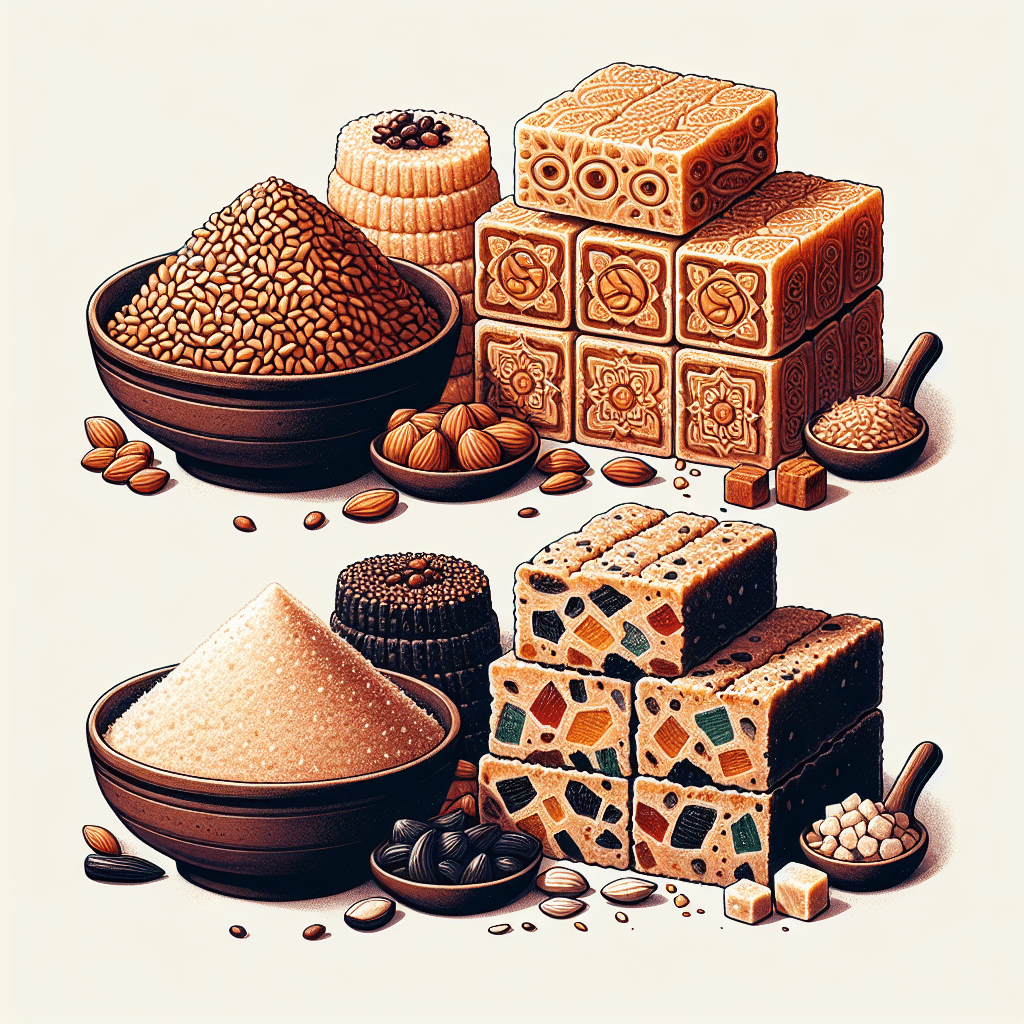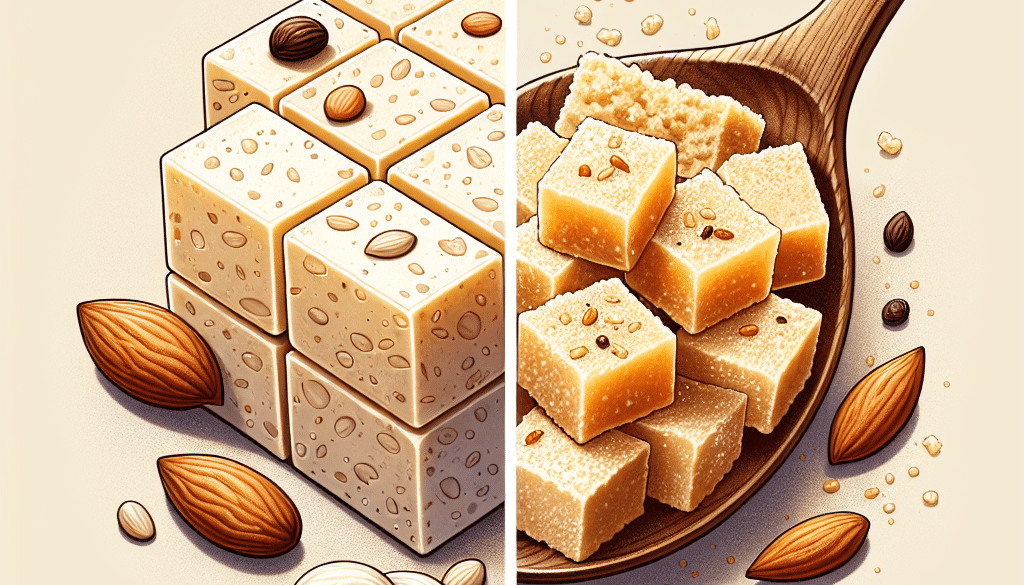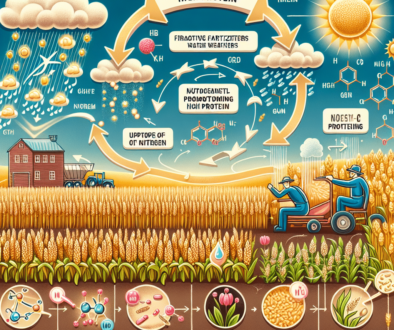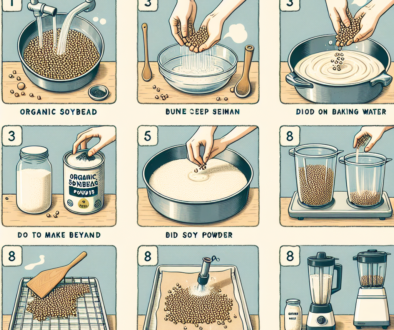What Are The Two Types Of Halva?
-
Table of Contents
- Exploring the Delightful Varieties of Halva: A Sweet Treat Across Cultures
- The Flour-Based Halva: A Middle Eastern Delicacy
- The Nut Butter-Based Halva: A Mediterranean Favorite
- Cultural Significance and Occasions
- Health Benefits and Nutritional Value
- Modern Twists and Innovations
- Conclusion: The Sweet World of Halva
- Enhance Your Diet with ETprotein’s High-Quality Protein Products
Exploring the Delightful Varieties of Halva: A Sweet Treat Across Cultures

Halva, a dense, sweet confection with a rich history, has been a staple in various cultures around the world. This delightful treat comes in many forms and flavors, but it is primarily categorized into two main types: flour-based and nut butter-based. In this article, we will delve into the origins, ingredients, and cultural significance of these two types of halva, providing a comprehensive understanding of this versatile sweet.
The Flour-Based Halva: A Middle Eastern Delicacy
Flour-based halva, often associated with the Middle East, is typically made from a base of wheat flour or semolina that is toasted in oil or butter. The process involves cooking the flour until it changes color and emits a nutty aroma. A sweet syrup, usually made from sugar or honey, is then added to the toasted flour along with various flavorings such as rosewater or saffron. The mixture is stirred until it thickens and is then poured into a mold to set.
- Regional Variations: While the basic ingredients remain the same, different regions add their unique touch to flour-based halva. For instance, in Iran, it is often flavored with rosewater and saffron, while in Turkey, it might include nuts or spices.
- Texture and Flavor: The texture of flour-based halva can range from slightly gelatinous to crumbly, depending on the preparation method. Its flavor is rich and buttery, with a sweetness that can be adjusted to taste.
The Nut Butter-Based Halva: A Mediterranean Favorite
Nut butter-based halva, commonly found in the Mediterranean and Balkan regions, is made from tahini (sesame seed paste) or other nut butters. The process involves mixing the nut butter with hot sugar syrup until the mixture becomes smooth and then letting it cool and crystallize. This type of halva is known for its distinctive crumbly texture and nutty flavor.
- Ingredients: The primary ingredient in nut butter-based halva is tahini, but variations may include other nut butters such as sunflower or peanut butter.
- Flavor Additions: To enhance the taste, ingredients like pistachios, almonds, or chocolate might be mixed into the halva. Vanilla and other extracts are also common flavor enhancers.
Cultural Significance and Occasions
Halva is not just a sweet treat; it holds cultural significance in many regions. It is often served during religious festivities, weddings, and funerals, symbolizing various aspects of life and tradition.
- In Jewish tradition, halva is eaten during Purim and as a comfort food during periods of mourning.
- In India and Pakistan, flour-based halva is served during celebrations and as prasad (a religious offering).
- In the Balkans and the Middle East, halva is a common dessert and a symbol of hospitality, often served to guests.
Health Benefits and Nutritional Value
Despite being a sweet treat, halva offers some nutritional benefits, particularly when made with healthy ingredients like sesame seeds, which are high in healthy fats, protein, and minerals.
- Rich in Minerals: Sesame seeds are a good source of calcium, magnesium, and iron.
- Antioxidant Properties: The seeds contain antioxidants that help in fighting oxidative stress in the body.
- Protein Content: Halva can be a source of plant-based protein, especially when made with tahini.
However, due to its high sugar content, halva should be consumed in moderation as part of a balanced diet.
Modern Twists and Innovations
Chefs and food enthusiasts around the world have been experimenting with halva, creating new versions that cater to contemporary tastes and dietary restrictions.
- Vegan halva eliminates dairy, using plant-based oils and natural sweeteners.
- Gluten-free halva uses alternative flours for those with gluten sensitivities.
- Artisanal halva makers are incorporating unconventional flavors like matcha, lavender, and coffee.
Conclusion: The Sweet World of Halva
In conclusion, halva is a versatile and beloved sweet that comes in two main types: flour-based and nut butter-based. Each type has its unique characteristics, flavors, and cultural significance. Whether enjoyed as part of a celebration, a comfort food, or simply as a treat, halva continues to be a testament to the rich culinary traditions of the regions it hails from. As we embrace the diversity of global cuisine, halva stands out as a sweet reminder of our shared love for confections that cross cultural boundaries.
Enhance Your Diet with ETprotein’s High-Quality Protein Products
If you’re looking to balance your sweet indulgences with high-quality protein intake, ETprotein offers a range of organic bulk vegan proteins that can complement your dietary needs. Their products, including various seed and bean proteins, are non-GMO, allergen-free, and boast a high purity of L-(+)-Ergothioneine. Whether you’re formulating new health foods, sports nutrition, or simply seeking to enrich your diet, ETprotein’s offerings provide a nutritious and versatile solution.
About ETprotein:
ETprotein, a reputable protein and L-(+)-Ergothioneine (EGT) Chinese factory manufacturer and supplier, is renowned for producing, stocking, exporting, and delivering the highest quality organic bulk vegan proteins and L-(+)-Ergothioneine. They include Organic rice protein, clear rice protein, pea protein, clear pea protein, watermelon seed protein, pumpkin seed protein, sunflower seed protein, mung bean protein, peanut protein, and L-(+)-Ergothioneine EGT Pharmaceutical grade, L-(+)-Ergothioneine EGT food grade, L-(+)-Ergothioneine EGT cosmetic grade, L-(+)-Ergothioneine EGT reference grade and L-(+)-Ergothioneine EGT standard. Their offerings, characterized by a neutral taste, non-GMO, allergen-free attributes, with L-(+)-Ergothioneine purity over 98%, 99%, cater to a diverse range of industries. They serve nutraceutical, pharmaceutical, cosmeceutical, veterinary, as well as food and beverage finished product distributors, traders, and manufacturers across Europe, USA, Canada, Australia, Thailand, Japan, Korea, Brazil, and Chile, among others.
ETprotein specialization includes exporting and delivering tailor-made protein powder and finished nutritional supplements. Their extensive product range covers sectors like Food and Beverage, Sports Nutrition, Weight Management, Dietary Supplements, Health and Wellness Products, and Infant Formula, ensuring comprehensive solutions to meet all your protein needs.
As a trusted company by leading global food and beverage brands and Fortune 500 companies, ETprotein reinforces China’s reputation in the global arena. For more information or to sample their products, please contact them and email sales(at)ETprotein.com today.












